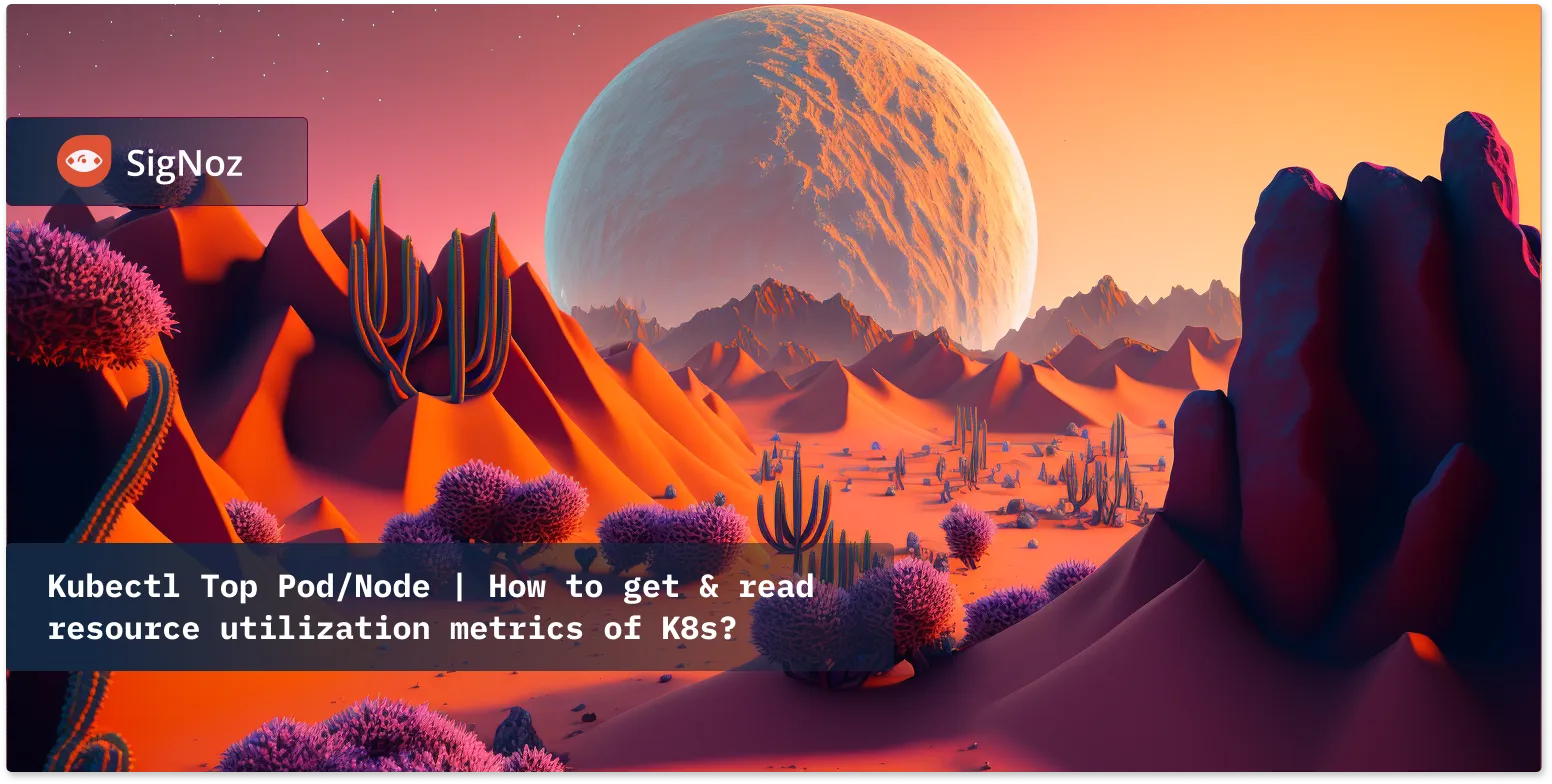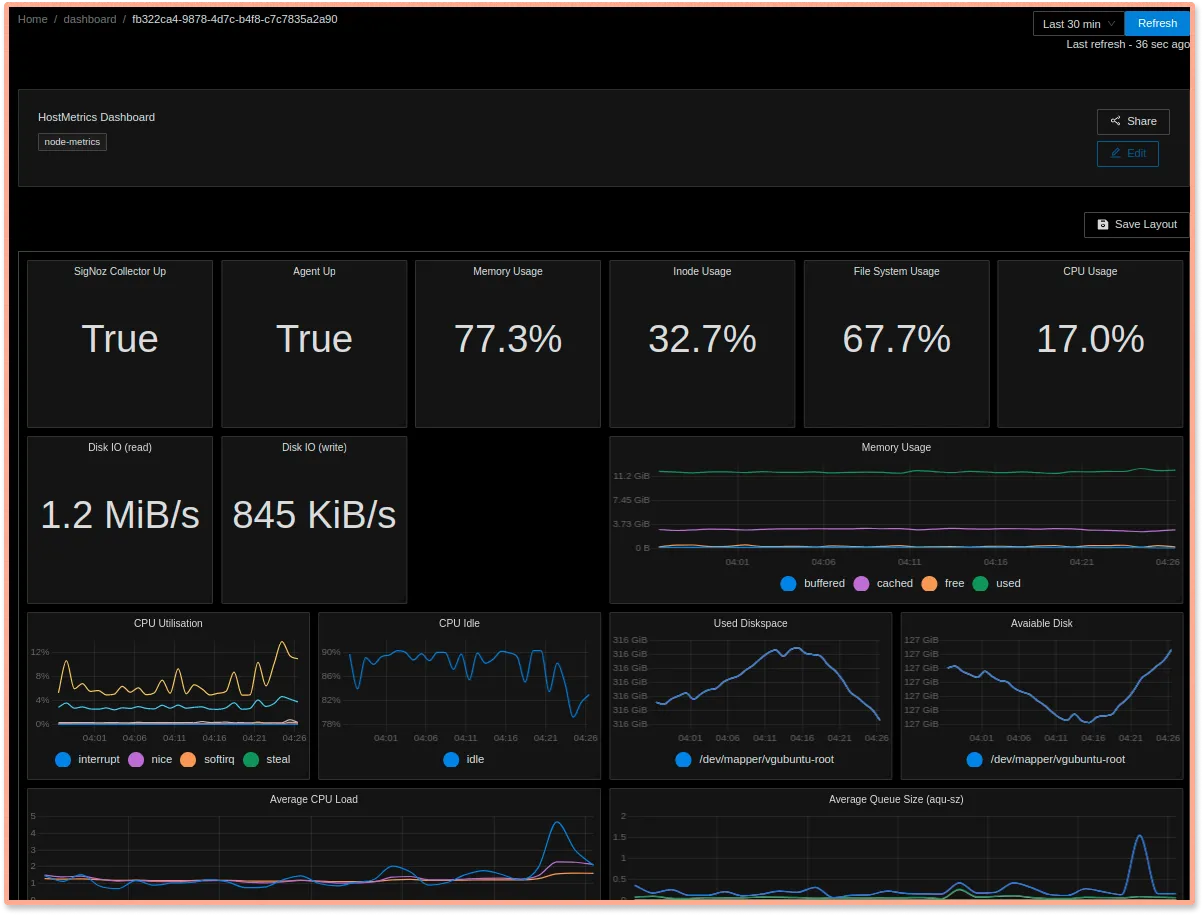Kubectl Top Pod/Node | How to get & read resource utilization metrics of K8s?
Kubectl Top command can be used to retrieve snapshots of resource utilization of pods or nodes in your Kubernetes cluster. Resource utilization is an important thing to monitor for Kubernetes cluster owners. In order to monitor resource utilization, you can keep track of things like CPU, memory, and storage.

In this article, we will see how to use kubectl Top command to get and read metrics about pods and nodes. We will also breakdown the output to understand what it means.
But before we get down to learn about Kubectl Top command, let’s have a brief overview of a few concepts in Kubernetes.
What is kubectl?
kubectl is the Kubernetes command-line tool, and it allows you to run commands against your Kubernetes cluster. kubectl lets you interact with your Kubernetes cluster for day-to-day management. For example, kubectl get nodes lets you retrieve details about nodes running in your cluster or namespace.
Under the hood, kubectl interacts with the API server. The API server is responsible for all communication between Kubernetes components, including both the internal components of your Kubernetes cluster and external components. kubectl sends out POST commands to the API server endpoint in order to execute its commands.
What is a pod in Kubernetes?
Kubernetes is meant to orchestrate the management of containers. Pods are the first level of abstraction that it provides over containers.
Pods are groups of one or more containers with shared resources like storage and networks. They are used as units of replication in cases where applications need to be scaled up or down.
What is a node in Kubernetes?
Nodes are where Kubernetes pods run. Nodes can be virtual machines, bare metal servers in a data center, or instances in a private or public cloud. Kubernetes uses nodes to handle on-demand scaling of resources.
A single node can have multiple pods separated by namespaces.
What is kubectl Top command?
As mentioned before, kubectl - pronounced (Kube: c-t-l) - is a CLI for running commands that can help you interact with a Kubernetes interface or resources in a k8 cluster. These resources include pods, deploy, replica set, etc.
A kubectl top is a command used to list all the running nodes and pods along with their resource utilization. It provides you a snapshot of resource utilization metrics like CPU, memory, and storage on each running node.
Each node in Kubernetes comes with cAdvisor, which is an open-source agent that monitors resource usage about containers. kubectl command gets resource utilization metrics from cAdvisor via the metrics-server.
To obtain these metrics, you need to run the kubectl top command which shows the CPU, memory, and network utilization for the containers, pods, or nodes. For the kubectl top command to work, you need to have metrics API installed. You can find instructions to install metrics API here.
Now that you have a brief understanding of the concepts let’s see how the kubectl top command operates.
Using kubectl top node
Running the kubectl top node command lists metrics of the current node which would look like this:
$ kubectl top node
NAME CPU(cores) CPU% MEMORY(bytes) MEMORY%
kind-control-plane 338m 4% 1662Mi 10%
How to read the output from kubectl top?
The output from kubectl top node gives you information about CPU(cores), CPU%, memory, and memory%. Let’s see what these terms mean:
- CPU(cores)
338mmeans 338 millicpu.1000mis equal to 1 CPU, hence 338m means 33.8% of 1 CPU. - CPU%
It is displayed only for nodes, and it stands for the total CPU usage percentage of that node. - Memory
Memory being used by that node - Memory%
It is also displayed only for nodes, and it stands for total memory usage percentage of that node.
Running the kubectl top node <node-name> command lists metrics for a specific node:
NAME CPU(cores) CPU% MEMORY(bytes) MEMORY%
kind-control-plane 338m 4% 1662Mi 10%
Running the kubectl top node <node-name> -containers command lists metrics for each container running on a specific node:
NAME CPU(cores) CPU% MEMORY(bytes) MEMORY%
nginx-653c7b42sd-4g5ce 20m 12% 14Mi 18%
nginx-653c7b42sd-7c9ae 15m 7% 12Mi 12%
Running the kubectl top node <node-name> -containers -n namespace command lists metrics for each container running on a specific node in a specific namespace:
NAME CPU(cores) CPU% MEMORY(bytes) MEMORY%
nginx-653c7b42sd-4g5ce 22m 12% 12Mi 19%
nginx-653c7b42sd-7c9ae 16m 7% 10Mi 16%
webserver-container 13m 5% 10Mi 15%
Using kubectl top pod command
Running the kubectl top pod command displays the metrics about pods from the default namespace which looks like this:
NAME CPU(Cores) MEMORY(Bytes)
nginx 3m 1Mi
nginx-653c7b42sd-4g5ce 3m 1Mi
nginx-653c7b42sd-7c9ae 3m 1Mi
Here Mi under memory stands for mebibytes.
Running the kubectl top pod command with --all-namespaces lists down pods from all namespaces in your k8s cluster. For example, below is a snapshot from SigNoz k8s cluster.
$ kubectl top pod --all-namespaces
NAMESPACE NAME CPU(cores) MEMORY(bytes)
kube-system coredns-558bd4d5db-k7mfl 8m 11Mi
kube-system coredns-558bd4d5db-qwrrk 8m 12Mi
kube-system etcd-kind-control-plane 32m 45Mi
kube-system kindnet-trm65 1m 7Mi
kube-system kube-apiserver-kind-control-plane 105m 408Mi
kube-system kube-controller-manager-kind-control-plane 22m 62Mi
kube-system kube-proxy-8n86t 2m 17Mi
kube-system kube-scheduler-kind-control-plane 5m 28Mi
kube-system metrics-server-57bfd75b9-bhrwl 5m 14Mi
local-path-storage local-path-provisioner-547f784dff-tjnqb 3m 9Mi
platform chi-signoz-cluster-0-0-0 43m 149Mi
platform clickhouse-operator-8cff468-hggdm 1m 24Mi
platform my-release-signoz-alertmanager-0 2m 14Mi
platform my-release-signoz-frontend-f8587978f-7wj8f 1m 6Mi
platform my-release-signoz-otel-collector-cbf578f44-69twr 4m 52Mi
platform my-release-signoz-otel-collector-metrics-5dcb767c77-5bgpt 4m 38Mi
platform my-release-signoz-query-service-0 3m 57Mi
platform my-release-zookeeper-0 5m 90Mi
You can also use the --namespace flag to get information about pods from a particular namespace. For example, in the below snapshot, we can see details about pods from the platform namespace.
$ kubectl top pod --namespace platform
NAME CPU(cores) MEMORY(bytes)
chi-signoz-cluster-0-0-0 44m 165Mi
clickhouse-operator-8cff468-hggdm 1m 24Mi
my-release-signoz-alertmanager-0 2m 14Mi
my-release-signoz-frontend-f8587978f-7wj8f 1m 6Mi
my-release-signoz-otel-collector-cbf578f44-69twr 5m 54Mi
my-release-signoz-otel-collector-metrics-5dcb767c77-5bgpt 5m 38Mi
my-release-signoz-query-service-0 3m 57Mi
my-release-zookeeper-0 4m 91Mi
Running the kubectl top pod -l <label-selector> command lists metrics for pods that match a specific label selector:
NAME CPU(Cores) MEMORY(Bytes)
webserver-1 3m 1Mi
webserver-2 5m 3Mi
Running the kubectl top pod <pod-name> -containers command lists metrics for each container running in a specific pod:
NAME CPU(cores) CPU% MEMORY(bytes) MEMORY%
nginx-653c7b42sd-4g5ce 20m 12% 14Mi 18%
nginx-653c7b42sd-7c9ae 15m 7% 12Mi 12%
Running the kubectl top pod -n <namespace> -containers command lists metrics for each container running in pods in a specific namespace:
NAME CPU(cores) CPU% MEMORY(bytes) MEMORY%
nginx-653c7b42sd-4g5ce 20m 12% 14Mi 18%
nginx-653c7b42sd-7c9ae 15m 7% 12Mi 12%
Running the kubectl top pod -l <label-selector> -containers command lists metrics for each container running in pods that match a specific label selector:
NAME CPU(cores) CPU% MEMORY(bytes) MEMORY%
webserver-1 50m 15% 40Mi 30%
mwebserver-2 26m 8% 15Mi 16%
Use Cases of kubectl top pod/node command
Here are some use cases where kubectl top pod or kubectl top node command can be useful:
Use cases of kubectl top node command:
Node Health Monitoring: Monitoring the resource usage of nodes to ensure they are not overburdened, which is crucial for maintaining cluster health.
Load Balancing: Identifying under-utilized or over-utilized nodes, which can inform decisions on workload distribution and node scaling.
Preventive Maintenance: Detecting nodes with consistently high resource usage, potentially indicating the need for maintenance or upgrade.
Use cases of kubectl top pod command:
Resource Optimization: Identifying pods consuming excessive CPU or memory resources, enabling optimization of pod resource allocation.
Troubleshooting: Helping diagnose issues in applications by monitoring pod resource usage, especially when pods are not performing as expected.
Capacity Planning: Assisting in understanding current pod resource usage, facilitating better decisions for scaling and infrastructure planning.
Conclusion
Resource utilization metrics are key to understanding the health of your Kubernetes cluster. From the article, you learned how to get resource utilization snapshots using the kubectl top command.
Though the kubectl top command gives you basic metrics about resource utilization, it is very convenient to inspect your nodes and pods at any time. For example, if you see that there is a sudden spike in your resource utilization, you can check which pod is consuming the most resources.
But if you're using Kubernetes in production, you can't rely on manual spot-checks to monitor your system's health and performance. Kubernetes provides us with a smarter way to manage our resources for scaling cloud-native applications on demand. You need to monitor your Kubernetes resources effectively. If you want to dive deeper into Kubernetes monitoring, you can check out SigNoz.

SigNoz is a full-stack open-source APM tool that can help you monitor your Kubernetes cluster. It uses OpenTelemetry to collect metrics from your K8s cluster for monitoring. OpenTelemetry is becoming the world standard for instrumentation of cloud-native applications, and it is backed by CNCF foundation, the same foundation under which Kubernetes graduated.
Getting started with SigNoz
SigNoz cloud is the easiest way to run SigNoz. Sign up for a free account and get 30 days of unlimited access to all features.
!https://signoz.io/assets/images/try-signoz-cloud-all-blog-cta-e236d6935472e7a48a103148be0117f7.webp
You can also install and self-host SigNoz yourself since it is open-source. With 16,000+ GitHub stars, open-source SigNoz is loved by developers. Find the instructions to self-host SigNoz.



